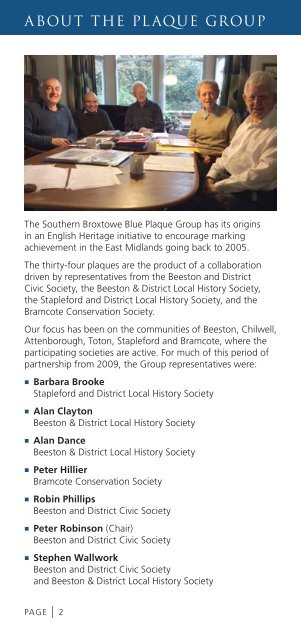GUIDE TO THE BLUE PLAQUES
BP%20final%20proof.2016.05.03
BP%20final%20proof.2016.05.03
You also want an ePaper? Increase the reach of your titles
YUMPU automatically turns print PDFs into web optimized ePapers that Google loves.
ABOUT <strong>THE</strong> PLAQUE GROUP<br />
HOW <strong>THE</strong> SCHEME WOR K ED<br />
The Southern Broxtowe Blue Plaque Group has its origins<br />
in an English Heritage initiative to encourage marking<br />
achievement in the East Midlands going back to 2005.<br />
The thirty-four plaques are the product of a collaboration<br />
driven by representatives from the Beeston and District<br />
Civic Society, the Beeston & District Local History Society,<br />
the Stapleford and District Local History Society, and the<br />
Bramcote Conservation Society.<br />
Our focus has been on the communities of Beeston, Chilwell,<br />
Attenborough, Toton, Stapleford and Bramcote, where the<br />
participating societies are active. For much of this period of<br />
partnership from 2009, the Group representatives were:<br />
• Barbara Brooke<br />
Stapleford and District Local History Society<br />
• Alan Clayton<br />
Beeston & District Local History Society<br />
• Alan Dance<br />
Beeston & District Local History Society<br />
• Peter Hillier<br />
Bramcote Conservation Society<br />
• Robin Phillips<br />
Beeston and District Civic Society<br />
• Peter Robinson (Chair)<br />
Beeston and District Civic Society<br />
• Stephen Wallwork<br />
Beeston and District Civic Society<br />
and Beeston & District Local History Society<br />
The Plaque Scheme, now closed, has been a remarkable<br />
example of collaborative working between participating<br />
societies and many others.<br />
To keep costs to a minimum the Group offered a free<br />
service from inception to completion, covering research,<br />
design, permissions where necessary, ordering and fixing.<br />
That service also included arranging twenty-seven formal<br />
unveilings, often involving the Mayors of Broxtowe and<br />
Stapleford, dignitaries and family members. Others were<br />
fixed without ceremony at the request of property owners.<br />
Plaques were cast from recycled aluminium and enamelled.<br />
An exception - Admiral Sir John Borlase Warren - was cast<br />
in bronze so that it could be set into the Walter Parker VC<br />
Memorial Square in Stapleford. All were prepared to designs<br />
based on English Heritage guidance by Leander Architectural<br />
of Dove Holes, Derbyshire, and became the responsibility<br />
of the property owner once fixed. Most are circular with a<br />
diameter between about 300mm (12”) and 460mm (18”).<br />
Each subject was treated as a separate self-financed project,<br />
supported by small donations from owners, families and<br />
other interested parties to cover individual plaque costs only.<br />
Costs of supplying and fixing the plaques were covered<br />
in this way. This Guide, written and produced by Group<br />
members, was sponsored as a separate project.<br />
Eleven of the plaques are within designated conservation<br />
areas (plaques 14, 15, 16, 17, 22, 23, 25, 27, 30, 33, 34),<br />
and nine required listed building consent, that is they are<br />
associated directly with a building of architectural or historic<br />
interest (plaques 1, 2, 6, 9, 15, 16, 27, 31, 32).<br />
PAGE | 2<br />
PAGE | 3


